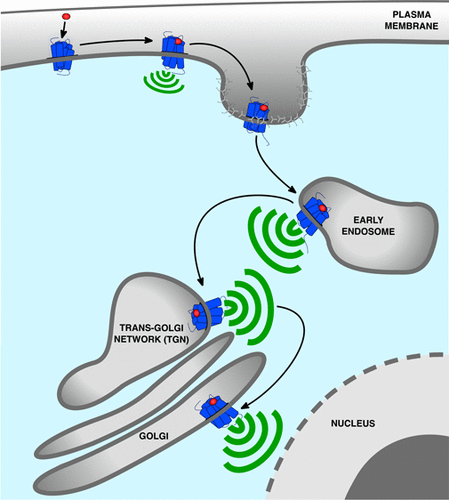当前位置:
X-MOL 学术
›
ACS Pharmacol. Transl. Sci.
›
论文详情
Our official English website, www.x-mol.net, welcomes your
feedback! (Note: you will need to create a separate account there.)
Emerging Role of Compartmentalized G Protein-Coupled Receptor Signaling in the Cardiovascular Field.
ACS Pharmacology & Translational Science ( IF 4.9 ) Pub Date : 2020-02-24 , DOI: 10.1021/acsptsci.0c00006 Bianca Plouffe 1 , Alex R B Thomsen 2 , Roshanak Irannejad 3
ACS Pharmacology & Translational Science ( IF 4.9 ) Pub Date : 2020-02-24 , DOI: 10.1021/acsptsci.0c00006 Bianca Plouffe 1 , Alex R B Thomsen 2 , Roshanak Irannejad 3
Affiliation

|
G protein-coupled receptors (GPCRs) are cell surface receptors that for many years have been considered to function exclusively at the plasma membrane, where they bind to extracellular ligands and activate G protein signaling cascades. According to the conventional model, these signaling events are rapidly terminated by β-arrestin (β-arr) recruitment to the activated GPCR resulting in signal desensitization and receptor internalization. However, during the past decade, emerging evidence suggest that many GPCRs can continue to activate G proteins from intracellular compartments after they have been internalized. G protein signaling from intracellular compartments is in general more sustained compared to G protein signaling at the plasma membrane. Notably, the particular location closer to the nucleus is beneficial for selective cellular functions such as regulation of gene transcription. Here, we review key GPCRs that undergo compartmentalized G protein signaling and discuss molecular considerations and requirements for this signaling to occur. Our main focus will be on receptors involved in the regulation of important physiological and pathological cardiovascular functions. We also discuss how sustained G protein activation from intracellular compartments may be involved in cellular functions that are distinct from functions regulated by plasma membrane G protein signaling, and the corresponding significance in cardiovascular physiology.
中文翻译:

房间隔G蛋白偶联受体信号在心血管领域的新兴作用。
G蛋白偶联受体(GPCR)是许多年来一直被认为仅在质膜起作用的细胞表面受体,在该处它们与细胞外配体结合并激活G蛋白信号级联。根据常规模型,这些信号传递事件通过β-arrestin(β-arr)募集迅速终止于活化的GPCR,从而导致信号脱敏和受体内化。但是,在过去的十年中,越来越多的证据表明,许多GPCR在被内化后,可以继续激活来自细胞内区室的G蛋白。与质膜处的G蛋白信号传导相比,来自细胞内区室的G蛋白信号传导通常更持久。值得注意的是 靠近细胞核的特定位置有利于选择性细胞功能,例如基因转录的调节。在这里,我们审查关键GPCRs进行隔室G蛋白信号转导,并讨论这种信号转导发生的分子考虑和要求。我们的主要重点是参与重要的生理和病理心血管功能调节的受体。我们还讨论了如何从细胞内区室持续G蛋白活化可能参与细胞功能,该功能不同于由质膜G蛋白信号传导调节的功能,以及在心血管生理学中的相应意义。我们审查了关键的GPCRs经历间隔G蛋白信号转导,并讨论了分子因素和这种信号转导发生的要求。我们的主要重点是参与重要的生理和病理心血管功能调节的受体。我们还讨论了如何从细胞内区室持续G蛋白活化可能参与细胞功能,该功能不同于由质膜G蛋白信号传导调节的功能,以及心血管生理学中的相应意义。我们审查了关键的GPCRs进行间隔G蛋白信号转导,并讨论了分子因素和这种信号转导发生的要求。我们的主要重点是与重要的生理和病理心血管功能调节相关的受体。我们还讨论了如何从细胞内区室持续G蛋白活化可能参与细胞功能,该功能不同于由质膜G蛋白信号传导调节的功能,以及心血管生理学中的相应意义。
更新日期:2020-02-24
中文翻译:

房间隔G蛋白偶联受体信号在心血管领域的新兴作用。
G蛋白偶联受体(GPCR)是许多年来一直被认为仅在质膜起作用的细胞表面受体,在该处它们与细胞外配体结合并激活G蛋白信号级联。根据常规模型,这些信号传递事件通过β-arrestin(β-arr)募集迅速终止于活化的GPCR,从而导致信号脱敏和受体内化。但是,在过去的十年中,越来越多的证据表明,许多GPCR在被内化后,可以继续激活来自细胞内区室的G蛋白。与质膜处的G蛋白信号传导相比,来自细胞内区室的G蛋白信号传导通常更持久。值得注意的是 靠近细胞核的特定位置有利于选择性细胞功能,例如基因转录的调节。在这里,我们审查关键GPCRs进行隔室G蛋白信号转导,并讨论这种信号转导发生的分子考虑和要求。我们的主要重点是参与重要的生理和病理心血管功能调节的受体。我们还讨论了如何从细胞内区室持续G蛋白活化可能参与细胞功能,该功能不同于由质膜G蛋白信号传导调节的功能,以及在心血管生理学中的相应意义。我们审查了关键的GPCRs经历间隔G蛋白信号转导,并讨论了分子因素和这种信号转导发生的要求。我们的主要重点是参与重要的生理和病理心血管功能调节的受体。我们还讨论了如何从细胞内区室持续G蛋白活化可能参与细胞功能,该功能不同于由质膜G蛋白信号传导调节的功能,以及心血管生理学中的相应意义。我们审查了关键的GPCRs进行间隔G蛋白信号转导,并讨论了分子因素和这种信号转导发生的要求。我们的主要重点是与重要的生理和病理心血管功能调节相关的受体。我们还讨论了如何从细胞内区室持续G蛋白活化可能参与细胞功能,该功能不同于由质膜G蛋白信号传导调节的功能,以及心血管生理学中的相应意义。











































 京公网安备 11010802027423号
京公网安备 11010802027423号